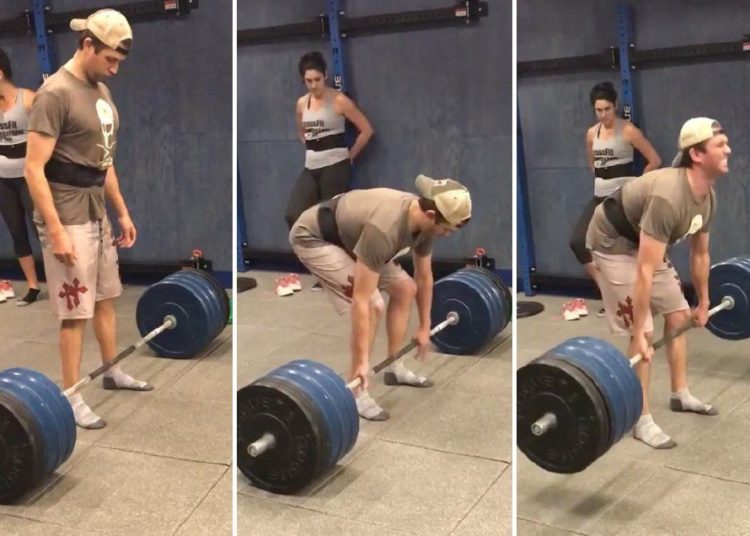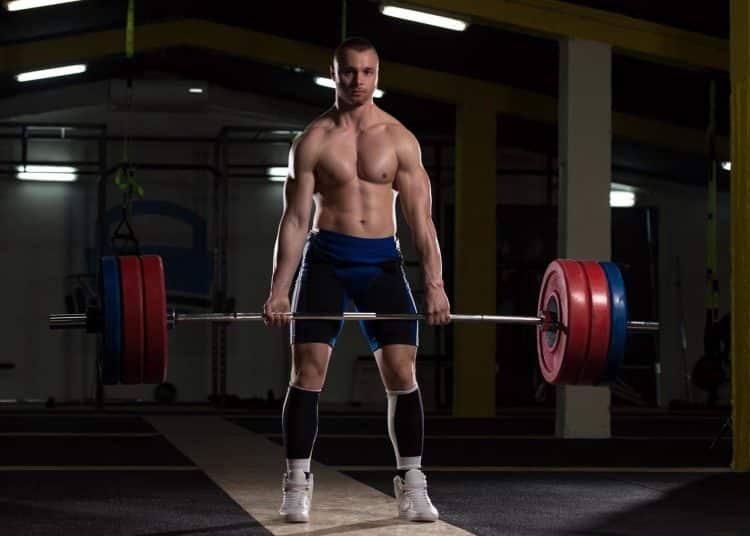Tag: deadlift
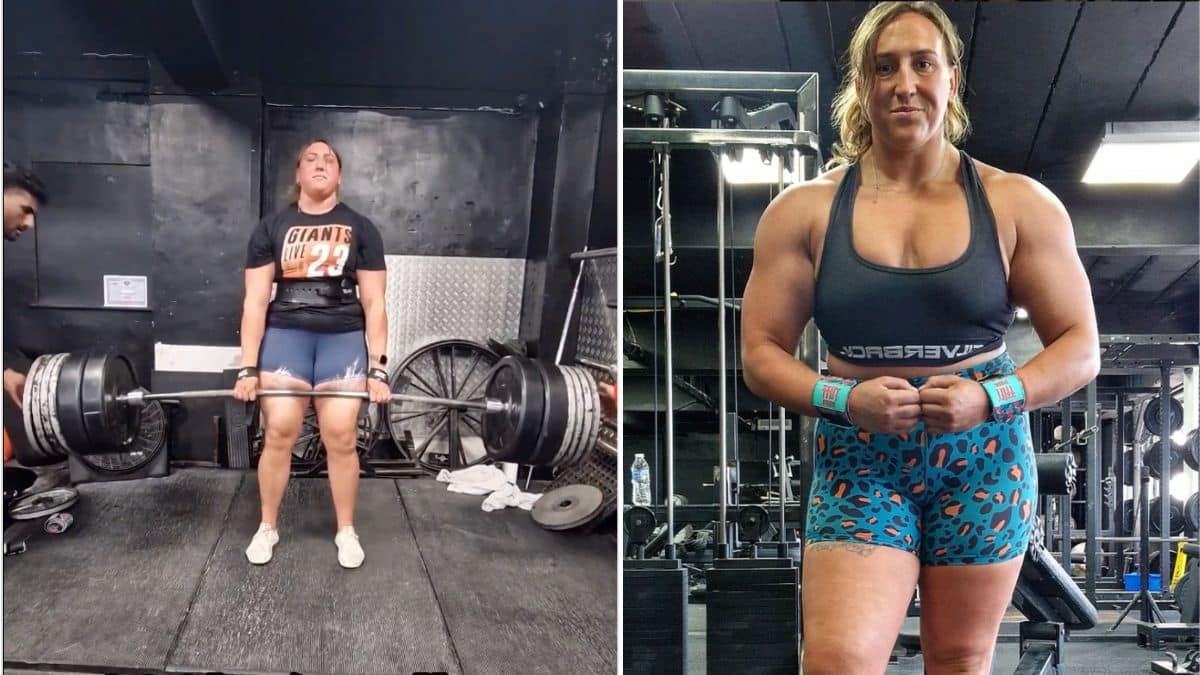
Strongwoman Lucy Underdown Crushes 280-kg (617.3-lb) Deadlift Four-Rep PR In Training
Lucy Underdown is easily the greatest deadlifter in the sport of Strongwoman, but one factor that makes her better than everyone is her hunger for improvement. Despite being on top of the deadlift charts, Lucy is still training harder than everyone. So, she often breaks records and sets new PRs, which was the case with her recent training session. Lucy landed a new 280-kilogram (617.3-pound) four-rep deadlift personal record (PR), and shared the video on Instagram.
Lucy Underdown performed the 280-kilogram (617.3-pound) four-rep deadlift with a conventional stance, as sumo is not allowed in Strongwoman. Regarding the equipment, she only used a lifting belt and a pair of lifting straps. Lucy did have some trouble placing all of the weight plates onto the barbell since the sleeves were loaded to their full capacity. However, she had spotters on each side of the bar to make sure that any plates that slide off are pushed back on.
“I’ve been feeling a bit under the weather and I’m going into a few days away so I’m very happy to have hit this as a PB”
Watch Lucy Underdown’s lift here:
Related: Lucy Underdown Pulls a 302.5-kg (667-lb) Unofficial Strongwoman Deadlift World Record in Training
Lucy Underdown has a very busy schedule ahead of her, since she plans on taking part in three competitions in the near future. The first one will be the 2023 Official Strongman Games European Championships on August 11-13. She will then take part in the 2023 Giants Live Britain’s Strongest Woman just over one month later, and wrap it up at the 2023 England’s Strongest Woman competition shortly after.
Lucy Underdown has already made one appearance this year at the 2023 UK’s Strongest Woman competition. She put up a sensational performance, despite narrowly losing the title to Rebecca Roberts in the final event of the competition. Regardless, she displayed one of the greatest lifts in the history of Strongwoman, having set a new Deadlift World Record of 305 kilograms (672.4 pounds).
Although Lucy Underdown is currently in great shape, she has also been one of the greatest athletes in the sport for some years now. She started competing in 2020 and got noticed for her impressive static strength. Still, she narrowly missed out on winning titles, but secured podium finishes in nearly all of her appearances.
However, in 2022 Lucy made quite a statement by winning Arnold’s UK Strongwoman Pro and England’s Strongest Woman. So, she now hopes to extend her list of titles and will have a few chances to do so this year already.
Related: Strongwoman Lucy Underdown Deadlifts 617lbs Ahead of 2022 UK’s Strongest Woman Contest
Judging by her new 280-kilogram (617.3-pound) four-rep deadlift PR, Lucy Underdown could soon reach a stage where she is able to perform multiple reps with 300 kilograms (661.4 pounds). Lucy’s remarkable improvement in deadlifts is evident, showcasing her dedication and potential for achieving even greater milestones in the future.
Published: 6 July, 2023 | 9:25 AM EDT

Powerlifter Serena Abweh Crushes 365-lb (165.6-kg) Raw Deadlift PR In Training
Serena Abweh has amassed a large following on social media during the past few years for her incredible transformation and mind-blowing feats of strength. Being an elite athlete, Serena is proficient in multiple lifts, but her deadlift prowess is on a level of its own. Although she has shared many heavy lifts during her powerlifting career, Serena recently announced that she locked out her heaviest deadlift ever and shared the video on Instagram. In the post, Serena is seen deadlifting a massive 365 pounds (165.6 kilograms) for a new PR (Personal Record).
Serena Abweh has perfected the sumo stance for deadlifts, so she utilized it to set her new 365-pound (165.6-kilogram) deadlift PR. Seeing how her PR was also raw, she was only able to use a lifting belt and some chalk. So, having no lifting straps to aid her, Serena grabbed the barbell with a mixed grip.
What makes Serena Abweh’s deadlift even more impressive is her bodyweight, since she weighed 105 pounds (47.6 kilograms) during the recent PR. This makes the lift 3.48x heavier than her bodyweight, which is beyond mind-blowing.
Watch the lift here:
Related: Transformation: Powerlifter Serena Abweh Shares a Powerful Message Following Her Battle With Anorexia
Serena Abweh has been going through a rough time in her life, as her partner recently passed away. He was also the owner of the gym in which Serena trains, “Legion Iron”, and she is now trying to keep it running. Regardless of everything that has been going on in her life, Serena has managed to find the strength to set a new 365-pound (165.6-kilogram) deadlift PR.
“We were supposed to go for the world record deadlift together and now I’m more motivated than ever to achieve it. Dis for you Gbear”
This is not the first time that Serena Abweh has encountered major setbacks in her life, since she has battled Anorexia in the past. However, she found a way to push through it with the help of powerlifting, and now serves as a motivation for thousands of people around the world.
After winning her battle with anorexia, Serena Abweh started doing powerlifting professionally. Since then, she has taken part in eight sanctioned meets and won seven of them, including Nationals, State Championships, and Collegiate Cups.
Serena Abweh’s Competition PRs
*Serena Abweh set all of her competition PRs during her most recent appearance at the 2022 USAPL Santa Fe Show of Strength.
Squat: 102.5 kilograms (225.9 pounds)
Bench Press: 72.5 kilograms (159.8 pounds)
Deadlift: 155 kilograms (341.7 pounds)
Total: 330 kilograms (727.5 pounds)
Related: Powerlifter Serena Abweh Claims 3.4x Bodyweight Deadlift PR of 355-lb (161-kg)
Serena Abweh’s Competition History
Personal Bests
Equip
Squat
Bench
Deadlift
Total
Dots
Raw
226
159.8
226
727.5
443.82
Competition Results
Place
Fed
Date
Competition
Division
Total
Dots
1
USAPL
2022-12-18
Santa Fe Show of Strength
FR-Jr
727.5
443.82
Location
USA-NM
Competition
Santa Fe Show of Strength
Division
FR-Jr
Age
22
Equipment
Raw
Class
105.8
Weight
100.1
Squat
187.4
-215
226
226
Bench
132.3
143.3
159.8
159.8
Deadlift
-297.6
314.2
341.7
341.7
GLP
94.75
1
USPA
2021-10-17
New Mexico State Championships
Juniors 20-23
683.4
406.27
Location
USA-NM
Competition
New Mexico State Championships
Division
Juniors 20-23
Age
20
Equipment
Raw
Class
105.8
Weight
103.6
Squat
187.4
203.9
220.5
220.5
Bench
126.8
137.8
-154.3
137.8
Deadlift
297.6
319.7
325.2
336.2
336.2
GLP
85.93
1
USAPL
2020-12-12
Collegiate Cup and Texas Open
FR-C
666.9
401.73
Location
USA-TX
Competition
Collegiate Cup and Texas Open
Division
FR-C
Age
20
Equipment
Raw
Class
103.6
Weight
101.8
Squat
198.4
-209.4
209.4
209.4
Bench
132.3
137.8
148.8
148.8
Deadlift
308.6
-325.2
-325.2
308.6
GLP
85.37
1
USAPL
2019-10-16
Raw Nationals
FR-T3
639.3
383.4
Location
USA-IL
Competition
Raw Nationals
Division
FR-T3
Age
18
Equipment
Raw
Class
103.6
Weight
102.4
Squat
192.9
203.9
209.4
209.4
Bench
121.3
126.8
132.3
132.3
Deadlift
281.1
297.6
-315.3
297.6
GLP
81.34
5
IPF
2019-06-04
World Classic Powerlifting Championships
Juniors
622.8
375.9
Location
Sweden
Competition
World Classic Powerlifting Championships
Division
Juniors
Age
18
Equipment
Raw
Class
103.6
Weight
101.5
Squat
187.4
198.4
-203.9
198.4
Bench
115.7
121.3
126.8
126.8
Deadlift
275.6
-297.6
297.6
297.6
GLP
79.93
1
USAPL
2018-10-11
Raw Nationals
FR-T2
574.3
346.34
Location
USA-WA
Competition
Raw Nationals
Division
FR-T2
Age
17
Equipment
Raw
Class
103.6
Weight
101.6
Squat
170.9
176.4
181.9
181.9
Bench
104.7
-110.2
115.7
115.7
Deadlift
248
264.6
276.7
276.7
GLP
73.63
1
USAPL
2018-08-11
Southwest Regional Championships
FR-T2
545.6
329.6
Location
USA-AZ
Competition
Southwest Regional Championships
Division
FR-T2
Age
17
Equipment
Raw
Class
103.6
Weight
101.4
Squat
154.3
165.3
176.4
176.4
Bench
104.7
110.2
-115.7
110.2
Deadlift
231.5
248
259
259
GLP
70.11
1
USPA
2018-05-26
APEMAN Classic Powerlifting Championship
Juniors 16-17
518.1
324.81
Location
USA-CA
Competition
APEMAN Classic Powerlifting Championship
Division
Juniors 16-17
Age
17
Equipment
Raw
Class
97
Weight
96.6
Squat
165.3
Bench
104.7
Deadlift
248
GLP
70.11
Data Source: Open Powerlifting. Last Updated: April 12, 2023
Analyze Lifts
As Serena Abweh states in her Instagram post, she is going after the World Record with more motivation than ever. So, her 365-pound (165.6-kilogram) deadlift PR is just the start of what we will be seeing from Serena in the future. The record will certainly require a great deal of hard work, but Serena is certainly capable of achieving it. Her life has been filled with overcoming the impossible, and the record would just be another achievement.
Published: 30 June, 2023 | 12:06 PM EDT
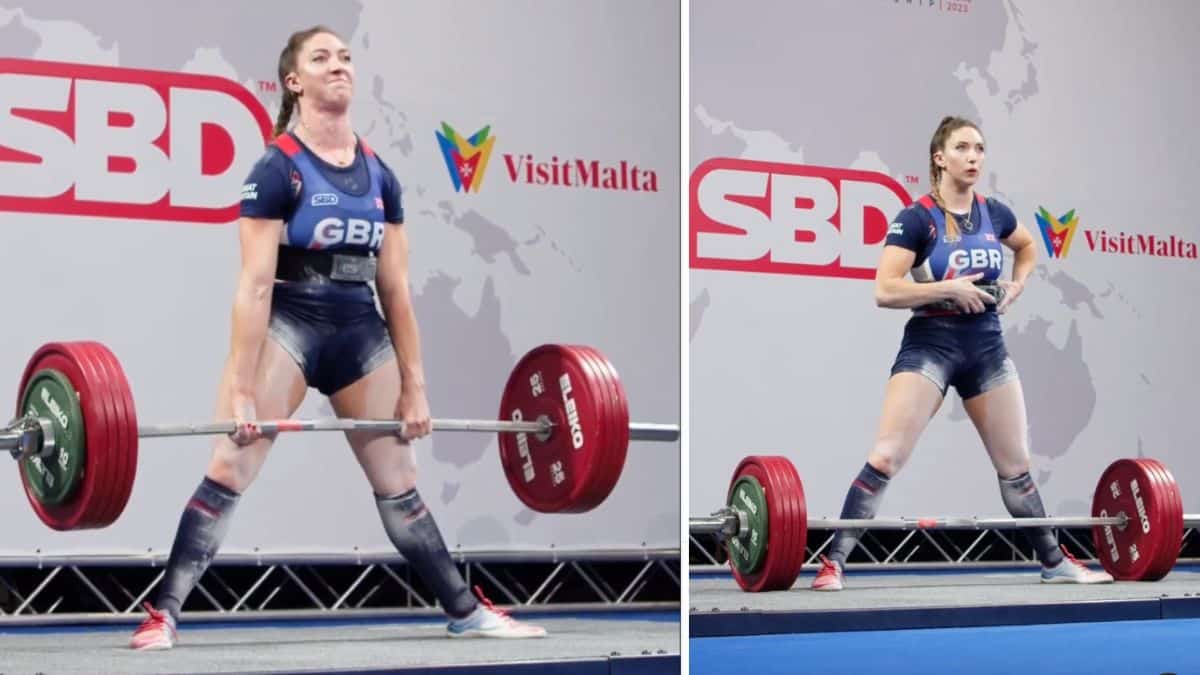
Sophia Ellis (76KG) Sets 245-kg (540.1-lb) Deadlift European and British Records at 2023 IPF World Classic Championships
The 76-kilogram weight class of the 2023 IPF World Classic Open Powerlifting Championships was one of the most heavily contested in the entire competition. Multiple elite women took part in this weight class, so anyone who managed to outperform others deserves great praise. Notably, Sophia Ellis crushed everyone on the deadlifts, setting new European and British Records with a lift of 245 kilograms (540.1 pounds).
There was no doubt about the validity of Sophia Ellis’ 245-kilogram (540.1-pound) record breaking deadlift since she made sure that every detail of her technique was perfect. Moreover, Sophia believed that there was more left in the tank because of the ease with which the deadlift moved.
“So pleased with how this weight moved and so psyched to know there is more there. 250kg pending ⏳”
Both records were in the possession of Sophia Ellis beforehand as well, but the more notable one, the EPF European Record, was set at the 2022 EPF European Classic Powerlifting Championships. At that competition, Sophia locked out 240.5 kilograms (530.2 pounds), but she has now lifted 4.5 kilograms (9.9 pounds) more.
Watch the lift here:
Related: Brittany Schlater (+84KG) Sets 693.5-kg (1,528.9-lb) Total World Record at 2023 IPF World Classic Powerlifting Championships
Sophia Ellis’ Full Performance
Sophia Ellis weighed in at 74.7 kilograms (164.7 pounds) for the 2023 IPF World Championships, making the record-breaking deadlift 3.3x her bodyweight. She also found success in other events, setting new competition PRs in Squat and Total. Moreover, her Total turned out to be a British Record as well.
Sophia Ellis performed exactly as she envisioned, successfully completing all nine of her attempts. She ended up taking fourth place overall, just short of the podium.
Squat
162.5 kilograms (358.2 pounds)172.5 kilograms (380.3 pounds)177.5 kilograms (391.3 pounds) — Competition PR
Bench Press
110 kilograms (242.5 pounds)115 kilograms (253.5 pounds)120 kilograms (264.5 pounds)
Deadlift
225 kilograms (496 pounds)237.5 kilograms (523.6 pounds)245 kilograms (534.6 pounds) — U76KG EPF European & British Record
Total — 542.5 kilograms (1,196 pounds) — U76KG British Record & Competition PR
“Last year’s worlds didn’t go to plan, so this time around I wanted to make sure I lifted to the standard I know I’m capable of…and that’s exactly what I did and more.”
Watch all lifts here:
Related: Anatolii Novopismennyi (105KG) Sets Squat & Total World Record at 2023 IPF World Classic Powerlifting Championships
Sophia Ellis’ Competition History
Personal Bests
Equip
Squat
Bench
Deadlift
Total
Dots
Raw
385.8
270.1
385.8
1185
525.37
Competition Results
Place
Fed
Date
Competition
Division
Total
Dots
1
BP
2023-03-16
Eleiko British Open Classic Championships
FR-O
1185
525.37
Location
UK
Competition
Eleiko British Open Classic Championships
Division
FR-O
Age
~26.5
Equipment
Raw
Class
167.6
Weight
164.2
Squat
352.7
374.8
385.8
385.8
Bench
237
253.5
264.6
264.6
Deadlift
496
523.6
534.6
534.6
GLP
106.99
1
EPF
2022-11-25
European Classic Powerlifting Championships
Open
1164
516.68
Location
Poland
Competition
European Classic Powerlifting Championships
Division
Open
Age
26
Equipment
Raw
Class
167.6
Weight
163.9
Squat
330.7
352.7
363.8
363.8
Bench
253.5
264.6
270.1
270.1
Deadlift
485
507.1
530.2
530.2
GLP
105.21
9
IPF
2022-09-23
Arnold Sports Festival
Open
1162.9
515.97
Location
England
Competition
Arnold Sports Festival
Division
Open
Age
~25.5
Equipment
Raw
Class
167.6
Weight
164
Squat
330.7
352.7
363.8
363.8
Bench
248
264.6
270.1
270.1
Deadlift
474
507.1
529.1
529.1
GLP
105.07
3
EPF
2022-08-02
European Bench Press Championships
Open
264.6
117.33
Location
Hungary
Competition
European Bench Press Championships
Division
Open
Age
~25.5
Equipment
Raw
Class
167.6
Weight
164.1
Bench
242.5
253.5
264.6
264.6
GLP
92.83
7
IPF
2022-06-06
World Classic Powerlifting Championships
Open
1129.9
506.43
Location
South Africa
Competition
World Classic Powerlifting Championships
Division
Open
Age
~25.5
Equipment
Raw
Class
167.6
Weight
160.9
Squat
347.2
369.3
374.8
374.8
Bench
242.5
259
-264.6
259
Deadlift
496
-523.6
-523.6
496
GLP
103.05
1
BP
2022-03-19
British Classic Womens Championships
FR-O
1158.5
516.61
Location
Scotland
Competition
British Classic Womens Championships
Division
FR-O
Age
~25.5
Equipment
Raw
Class
167.6
Weight
162.5
Squat
347.2
363.8
374.8
374.8
Bench
237
248
260.1
260.1
Deadlift
474
501.6
523.6
523.6
GLP
105.16
1
BP
2022-02-19
British Classic Bench Press Championships
FR-O
248
110.28
Location
England
Competition
British Classic Bench Press Championships
Division
FR-O
Age
~25.5
Equipment
Raw
Class
167.6
Weight
163.4
Bench
231.5
248
248
GLP
87.18
2
EPF
2021-12-03
European Classic Powerlifting Championships
Open
1103.4
494.94
Location
Sweden
Competition
European Classic Powerlifting Championships
Division
Open
Age
25
Equipment
Raw
Class
167.6
Weight
160.7
Squat
319.7
341.7
352.7
352.7
Bench
231.5
237
242.5
242.5
Deadlift
463
485
508.2
508.2
GLP
100.71
4
IPF
2021-10-22
World Bench Press Championships
Open
242.5
108.9
Location
Lithuania
Competition
World Bench Press Championships
Division
Open
Age
~24.5
Equipment
Raw
Class
167.6
Weight
160.4
Bench
220.5
231.5
242.5
242.5
GLP
85.83
4
IPF
2021-09-23
World Classic Powerlifting Championships
Open
1080.3
491.23
Location
Sweden
Competition
World Classic Powerlifting Championships
Division
Open
Age
~24.5
Equipment
Raw
Class
167.6
Weight
156.7
Squat
336.2
352.7
-363.8
352.7
Bench
-226
226
-237
226
Deadlift
451.9
479.5
501.6
501.6
GLP
99.88
1
BP
2021-09-04
British Open Classic
FR-O
1080.3
485.28
Location
England-NW
Competition
British Open Classic
Division
FR-O
Age
~24.5
Equipment
Raw
Class
167.6
Weight
160.3
Squat
330.7
352.7
363.8
363.8
Bench
231.5
242.5
-248
242.5
Deadlift
451.9
474
-501.6
474
GLP
98.73
1
BP
2021-08-07
British Classic Bench Press Championships
FR-O
248
110.76
Location
England
Competition
British Classic Bench Press Championships
Division
FR-O
Age
~24.5
Equipment
Raw
Class
167.6
Weight
162
Bench
248
-260.1
-260.1
248
GLP
87.44
1
EPA
2021-06-11
English Bench Press Championships
FR-O
259
115.94
Location
England
Competition
English Bench Press Championships
Division
FR-O
Age
~24.5
Equipment
Raw
Class
167.6
Weight
161.4
Bench
242.5
259
-264.6
259
GLP
91.46
3
BP
2020-03-08
Womens British Classic
FR-O
1003.1
453.34
Location
England
Competition
Womens British Classic
Division
FR-O
Age
~23.5
Equipment
Raw
Class
158.7
Weight
158.5
Squat
286.6
308.6
325.2
325.2
Bench
-220.5
220.5
-231.5
220.5
Deadlift
418.9
446.4
457.5
457.5
GLP
92.2
1
BP
2020-02-23
British Classic Bench Press Championships
F-C-Open
226
102.05
Location
England
Competition
British Classic Bench Press Championships
Division
F-C-Open
Age
~23.5
Equipment
Raw
Class
158.7
Weight
158.7
Bench
209.4
220.5
226
226
GLP
80.29
2
BP
2019-11-23
Home Nations Championships
FR-O
931.5
420.96
Location
UK
Competition
Home Nations Championships
Division
FR-O
Age
~22.5
Equipment
Raw
Class
158.7
Weight
158.5
Squat
264.6
297.6
308.6
308.6
Bench
192.9
203.9
209.4
209.4
Deadlift
374.8
413.4
-446.4
413.4
GLP
85.62
1
BP
2019-10-30
British Juniors Classic Powerlifting Championships
FR-Jr
964.5
427.32
Location
UK
Competition
British Juniors Classic Powerlifting Championships
Division
FR-Jr
Age
~22.5
Equipment
Raw
Class
185.2
Weight
164.5
Squat
286.6
308.6
319.7
319.7
Bench
203.9
215
-220.5
215
Deadlift
396.8
429.9
-446.4
429.9
GLP
87.03
1
CommonwealthPF
2019-09-15
Commonwealth Championships
Juniors
220.5
99.88
Location
Canada
Competition
Commonwealth Championships
Division
Juniors
Age
~22.5
Equipment
Raw
Class
158.7
Weight
157.8
Bench
209.4
215
220.5
220.5
GLP
78.52
1
CommonwealthPF
2019-09-15
Commonwealth Championships
Juniors
976.6
443.08
Location
Canada
Competition
Commonwealth Championships
Division
Juniors
Age
~22.5
Equipment
Raw
Class
158.7
Weight
157.4
Squat
292.1
314.2
-330.7
314.2
Bench
209.4
221.6
-227.1
221.6
Deadlift
418.9
440.9
-457.5
440.9
GLP
90.1
2
EPF
2019-08-07
European Classic Bench Press Championships
Juniors
220.5
98.47
Location
Luxembourg
Competition
European Classic Bench Press Championships
Division
Juniors
Age
~22.5
Equipment
Raw
Class
185.2
Weight
162
Bench
209.4
-220.5
220.5
220.5
GLP
77.73
1
EPA
2019-06-22
English Bench Press Championships
FR-Jr
209.4
94.69
Location
England
Competition
English Bench Press Championships
Division
FR-Jr
Age
~22.5
Equipment
Raw
Class
158.7
Weight
158.4
Bench
198.4
209.4
-220.5
209.4
GLP
74.48
1
EPA
2019-05-25
Womens All England Powerlifting Championships
FR-Jr
953.5
432.58
Location
England
Competition
Womens All England Powerlifting Championships
Division
FR-Jr
Age
~22.5
Equipment
Raw
Class
158.7
Weight
157.4
Squat
281.1
297.6
314.2
314.2
Bench
198.4
215
-220.5
215
Deadlift
402.3
424.4
424.4
GLP
87.96
5
IPF
2019-05-18
World Bench Press Championships
Juniors
209.4
94.81
Location
Japan
Competition
World Bench Press Championships
Division
Juniors
Age
~22.5
Equipment
Raw
Class
158.7
Weight
158
Bench
192.9
209.4
-231.5
209.4
GLP
74.55
8
BP
2019-03-02
British Womens Classic Powerlifting Championships
F-C-Open
898.4
408.52
Location
UK
Competition
British Womens Classic Powerlifting Championships
Division
F-C-Open
Age
~22.5
Equipment
Raw
Class
158.7
Weight
156.7
Squat
264.6
286.6
303.1
303.1
Bench
181.9
-192.9
192.9
192.9
Deadlift
402.3
-424.4
-424.4
402.3
GLP
83.06
2
BP
2019-02-23
British Classic Bench Press Championships
F-C-U23
192.9
87.72
Location
UK
Competition
British Classic Bench Press Championships
Division
F-C-U23
Age
~22.5
Equipment
Raw
Class
158.7
Weight
156.7
Bench
181.9
192.9
-198.4
192.9
GLP
68.89
1
EPA
2018-10-01
Greater London Push Pull
F-C-Open
573.2
254.86
Location
England
Competition
Greater London Push Pull
Division
F-C-Open
Age
~21.5
Equipment
Raw
Class
185.2
Weight
163.4
Bench
170.9
-187.4
187.4
187.4
Deadlift
352.7
374.8
385.8
385.8
7
BP
2018-09-22
British Junior Womens Powerlifting Championships
F-C-U23
821.2
373.73
Location
UK
Competition
British Junior Womens Powerlifting Championships
Division
F-C-U23
Age
~21.5
Equipment
Raw
Class
158.7
Weight
156.5
Squat
220.5
242.5
264.6
264.6
Bench
165.3
181.9
-192.9
181.9
Deadlift
341.7
358.3
374.8
374.8
GLP
75.98
2
EPA
2018-07-07
Greater London Divisional Championships
F-C-Open
738.5
336.89
Location
England
Competition
Greater London Divisional Championships
Division
F-C-Open
Age
~21.5
Equipment
Raw
Class
158.7
Weight
155.9
Squat
198.4
-220.5
220.5
220.5
Bench
143.3
159.8
176.4
176.4
Deadlift
308.6
341.7
-363.8
341.7
GLP
68.49
3
EPA
2018-03-18
GL Divisional
F-C-Open
666.9
301.17
Location
England
Competition
GL Divisional
Division
F-C-Open
Age
~21.5
Equipment
Raw
Class
158.7
Weight
158.7
Squat
165.3
198.4
198.4
Bench
137.8
148.8
-154.3
148.8
Deadlift
286.6
308.6
319.7
319.7
GLP
61.25
Data Source: Open Powerlifting. Last Updated: April 12, 2023
Analyze Lifts
Sophia Ellis has been competing for five years, but she has already taken part in 30 sanctioned competitions. She has won 14 of them, with the most notable being the 2022 EPF European Classic Powerlifting Championships.
Sophia Ellis has been getting consistently better over the past years, which will hopefully continue for years to come. With a new European Deadlift Record, she proved that she is performing better than she ever has before. As she states, there is still much room to improve. So, Sophia will continue improving and chasing world records.
2023 IPF World Championships Related Content
Published: 30 June, 2023 | 10:11 AM EDT
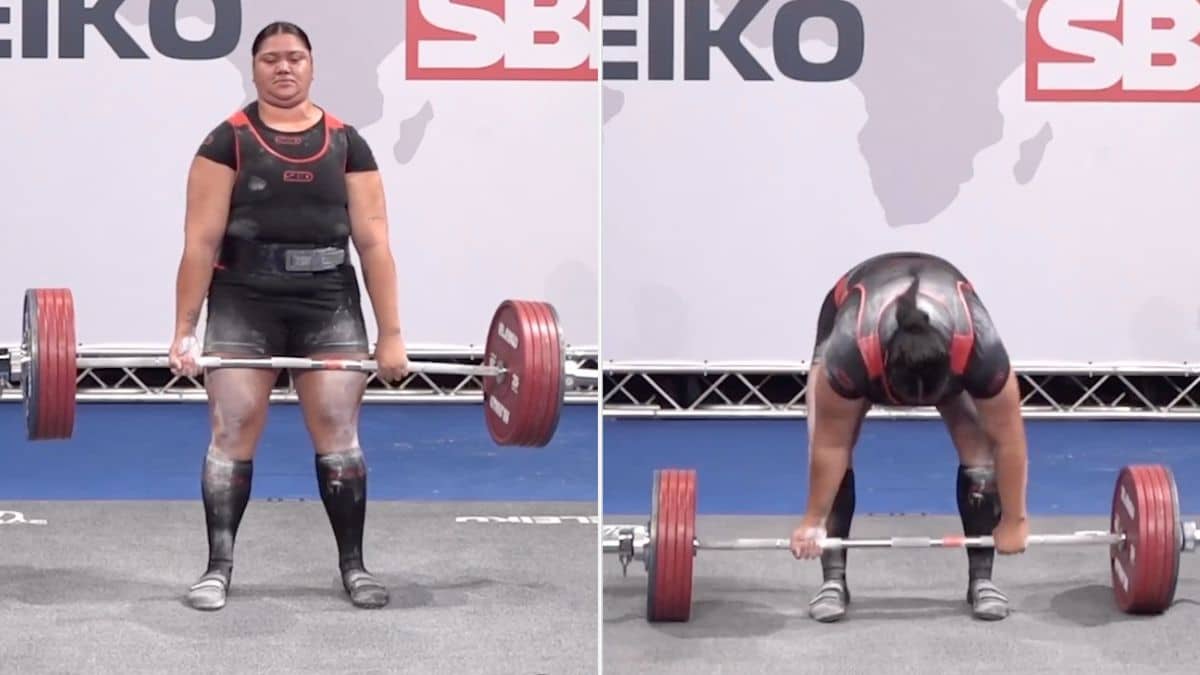
Natalie Laalaai (+84KG) Sets a 268-kg (690.8-lb) Deadlift World Record at 2023 IPF World Classic Open Powerlifting Championships
The 2023 IPF World Classic Open Powerlifting Championships were definitely a record-breaking event, with historic lifts being displayed on each day of the competition. One of those came from Natalie Laalaai, who was representing Australia in the raw +84-kilogram weight class. Despite the competitiveness of her weight class, Natalie emerged as the greatest deadlifter by a mile, but that was not surprising since she also set a new 268-kilogram (690.8-pound) Raw Deadlift IPF World Record.
The previous record stood at 257.5 kilograms (567.7 pounds) and was in possession of Sarah Brenner who set it at the 2019 NAPF Pan-American Powerlifting Championships. Sarah gracefully congratulated Natalie Laalaai on her achievement with a comment on Instagram.
“I’ve held that record since 2019, it’s yours now. Congrats on an amazing pull! ?”
So, Natalie Laalaai broke the World Record on her first attempt at 258 kilograms (568.8 pounds) and had two more attempts to advance it. Natalie’s second deadlift of 268 kilograms (690.8 pounds) marked an improved World Record, but also turned out to be her max. She did try to lift 275 kilograms (607.4 pounds) on her third and final attempt, but was unsuccessful.
Watch the deadlift here:
Related: Brittany Schlater (+84KG) Sets 693.5-kg (1,528.9-lb) Total World Record at 2023 IPF World Classic Powerlifting Championships
Natalie Laalaai’s Full Performance
Natalie Laalaai was unable to reach a podium spot, as her Total of 640.5 kilograms (1,412.1 pounds) was enough for a fifth-place finish. However, she did successfully complete eight out of her nine attempts, only missing her final deadlift. This resulted in some new Competition PRs and a World Record Deadlift.
Squat
232.5 kilograms (512.6 pounds)
242.5 kilograms (534.6 pounds)
250 kilograms (551.2 pounds) — Competition PR
Bench Press
115 kilograms (253.5 pounds)
120 kilograms (264.6 pounds)
122.5 kilograms (270.1 pounds) — Competition PR
Deadlift
258 kilograms (568.8 pounds)
268 kilograms (590.8 pounds) — +84KG IPF World Record
Unsuccessful — 275.5 kilograms (607.4 pounds)
Total — 640.5 kilograms (1,412.1 pounds) — Competition PR
Related: Anatolii Novopismennyi (105KG) Sets Squat & Total World Record at 2023 IPF World Classic Powerlifting Championships
The 2023 IPF World Championships were Natalie Laalaai’s first International powerlifting appearance ever, but she definitely made the most of it. She also took part in six more sanctioned competitions in Australia and secured five wins overall during her career.
Natalie Laalaai’s Competition History
Personal Bests
Equip
Squat
Bench
Deadlift
Total
Dots
Raw
507.1
237
507.1
1306.2
465.62
Wraps
573.2
242.5
573.2
1333.8
471.01
Competition Results
Place
Fed
Date
Competition
Division
Total
Dots
1
APU
2022-10-14
National Classic Open Powerlifting and Bench Press Championships
FR-O
1306.2
465.62
Location
Australia-QLD
Competition
National Classic Open Powerlifting and Bench Press Championships
Division
FR-O
Age
27
Equipment
Raw
Class
185.2
Weight
287.5
Squat
463
490.5
507.1
507.1
Bench
209.4
226
237
237
Deadlift
529.1
562.2
-595.2
562.2
GLP
100.31
1
APU
2022-05-01
WA State Classic and Equipped Powerlifting and Bench Press Championships
FR-O
1273.2
452.88
Location
Australia-WA
Competition
WA State Classic and Equipped Powerlifting and Bench Press Championships
Division
FR-O
Age
~26.5
Equipment
Raw
Class
185.2
Weight
290.3
Squat
463
485
-496
485
Bench
220.5
231.5
237
237
Deadlift
501.6
529.1
551.2
551.2
GLP
97.64
2
APU
2021-11-20
Legendary Open
FR-O
1008.6
354.91
Location
Australia-WA
Competition
Legendary Open
Division
FR-O
Age
26
Equipment
Raw
Class
185.2
Weight
308.9
Squat
308.6
352.7
396.8
396.8
Bench
154.3
176.4
192.9
192.9
Deadlift
-352.7
374.8
418.9
418.9
GLP
76.8
1
GPC-AUS
2020-09-05
WA State Powerlifting Championships
F-OR
1333.8
471.01
Location
Australia-WA
Competition
WA State Powerlifting Championships
Division
F-OR
Age
25
Equipment
Wraps
Class
242.5
Weight
301.8
Squat
529.1
-551.2
573.2
573.2
Bench
220.5
231.5
242.5
242.5
Deadlift
496
518.1
-540.1
518.1
1
GPC-AUS
2019-09-14
Perth Cup
F-OR
1190.5
424.75
Location
Australia-WA
Competition
Perth Cup
Division
F-OR
Age
24
Equipment
Wraps
Class
242.5
Weight
286.3
Squat
440.9
463
485
485
Bench
176.4
198.4
-220.5
198.4
Deadlift
440.9
485
507.1
507.1
Data Source: Open Powerlifting. Last Updated: April 12, 2023
Analyze Lifts
Natalie Laalaai revealed that she has never had as much fun as she did at the 2023 IPF World Championships. But she is also grateful that her two-year-old daughter was there to witness the World Record, as Natalie wants to be a great role model for her. So, having tasted success with a World Record Deadlift, Natalie will be more motivated than ever to continue making a name for herself in the sport.
2023 IPF World Championships Related Content
Published: 29 June, 2023 | 4:41 PM EDT
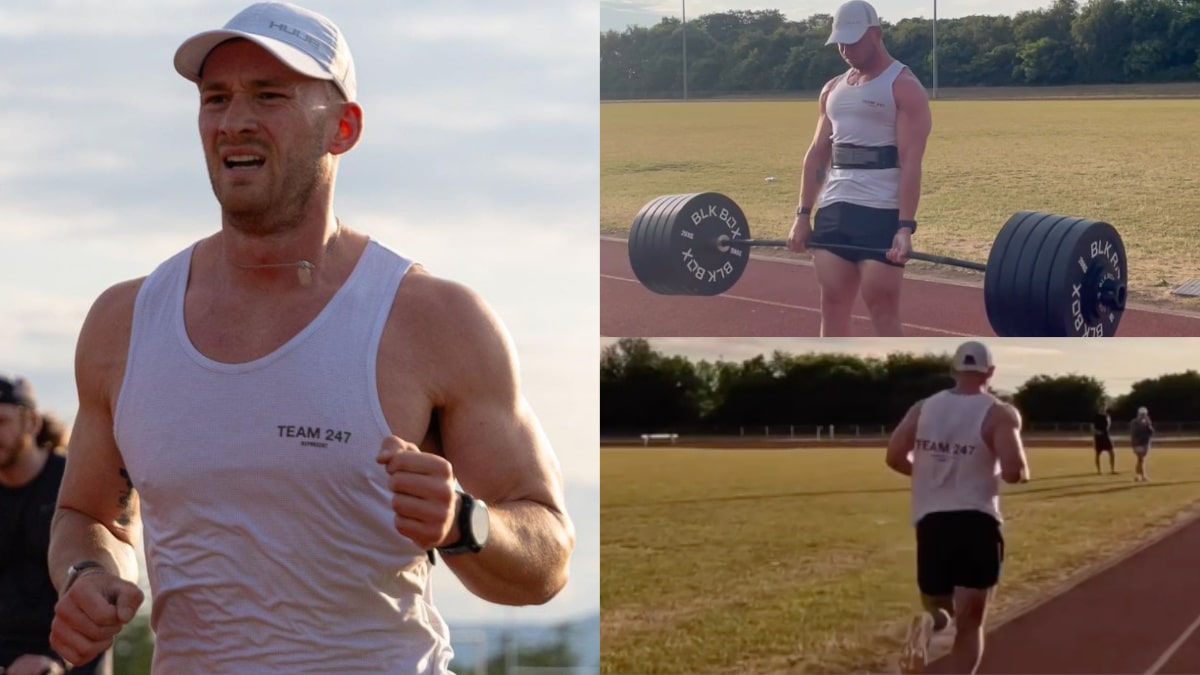
Hybrid Athlete Fergus Crawley Smashes 500-lb Deadlift & 5Km Run in Under 20 Mins
Hybrid athlete Fergus Crawley made a name for himself with his insane feats of strength and endurance, pushing beyond the boundaries of typical capabilities. Not only can he lift heavy weights, but he also combines them with challenging cardio workouts. In a recent post made on Instagram, Crawley smashed a huge 500-pound deadlift and ran 5 kilometers in less than 20 minutes.
Most fitness enthusiasts find inspiration from their favorite athletes and eventually decide to pursue an area of their interest whether it be strength, cardio, endurance, or bodybuilding. Former US Navy Seal David Goggins carved out his own space in the fitness community with his ironclad mind and crazy achievements in long-distance running. His friend Cameron Hanes is another popular figure known for his intense training methods, long-distance running, and bowhunting activities.
Scottish athlete Fergus Crawley falls under a similar category of high-performing individuals. He started out as a powerlifter with impressive wins on the regional circuit, including at the 2015 World Championships and 2016 European Championships. He decided to move on from professional competition and became a hybrid athlete to test his limits. He stands as one of only two men to have performed 500-lb squats and completed a sub-5-minute-mile on the same day.
In July 2020, Crawley challenged himself to the brutal task of running a mile in under five minutes, squatting 501 pounds, and running a marathon in a single day. He started off with the squat and later recorded a 43.9km (27.28 miles) run in five hours.
Crawley took on the insane 1200Twelve Challenge, where he lifted over 1,200 pounds combined on all three powerlifting lifts and completed The Outlaw Ironman Triathlon in under 12 hours in July 2021.
Hybrid Athlete Fergus Crawley Smashes 500-lb Deadlift & 5Km Run in Under 20 Mins
In a recent Instagram post, Fergus Crawley crushed a 500-pound deadlift and ran five kilometers in under 20 minutes.
“500lbs Deadlift + 5km: under 20 mins,” he wrote. “For those that’ll ask: I’m 181cm tall, and weigh 93.5kg.”
Fans shared their reactions to his unreal feat in the comments.
“You should do a thousand pound deadlift and run a sub 3hr marathon next,” commented a user.
“This is wildly impressive! People who haven’t lifted that much or ran that pace have no idea how hard this is! Great work!” wrote another.
“Damn, that’s impressive.”
“Jheeze. Inspo right there”
“THE HYBRID ?”
“What a fucking animal”
“Gotta step my game up.”
With fitness a number one priority for many right now, running has become a go-to activity. However, some social media personalities bite off more than they can chew. This was the case for YouTuber Tom Morley who attempted to run a 5K for 30 days straight. Unfortunately, on day 22, he broke his leg and had to suspend the challenge. He reported losing nine pounds as a result of the change in lifestyle.
RELATED: Fasted Running Explained: Benefits and Precautions
Fergus Crawley added another tremendous achievement to his already stacked record book. His latest offering will inspire many fans to work out and improve their fitness game.
Published: 28 June, 2023 | 3:55 PM EDT
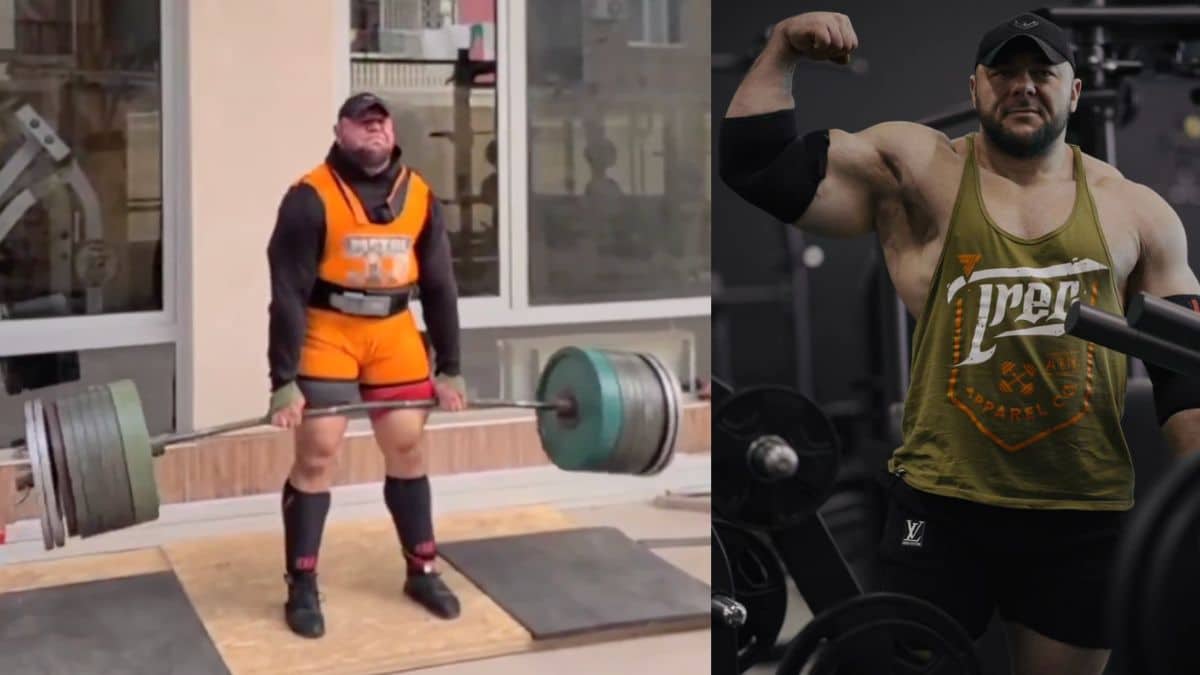
Ivan Makarov Lifts 476-kg (1,049.4-lb) Deadlift Two-Rep PR In Preparation For His Final World Record Attempt
Ivan Makarov has been the main contender for the deadlift World Record for a couple of years now, but he always fell short of the historic mark. However, with the newest update coming from Ivan, it looks like this could be his year. The elite Strongman is specialized in the deadlift, meaning his technique is close to perfect, but he has still managed to find a way to improve. This was seen in a training session performed approximately a week ago, when Ivan loaded up 476 kilograms (1,049.4 pounds) for a new deadlift two-rep PR (Personal Record) and crushed it. He then shared the achievement on Instagram.
Ivan Makarov put on a deadlift suit, lifting straps, and a lifting belt to set a 476-kilogram (1,049.4-pound) deadlift two-rep PR. All of these components are allowed in Strongman, so he will be able to use all of the equipment when he attempts the deadlift in a competition as well.
Watch Ivan Makarov’s lift here:
Related: Strongman Ivan Makarov Pulls an Incredible 483-kg (1,064.8-lb) Deadlift At 2022 Eisenhart Black Competition
Ivan Makarov has dedicated his career to achieving an All-Time World Record Deadlift, but he has yet to accomplish it. Despite falling just short of making history, he remains determined to reach his goal. With time on his side, he continues to strive towards breaking the record. Ivan needs to deadlift over 501 kilograms (1,104.5 pounds) to break the record set by Hafthor Bjornsson in 2020.
Only two months are left until Ivan Makarov’s next appearance, which will be at the 2023 Giants Live Deadlift World Championships. This competition will take place on September 2nd in Cardiff, Wales. Gathering the 15 greatest deadlifters in the world, the only goal of the competition will be to lock out 505 kilograms (1,113.3 pounds). If anyone succeeds, they will be rewarded with $55,000. So, Ivan is hoping to have the greatest day of his life.
However, Ivan Makarov announced on Instagram that the 2023 Giants Live Deadlift World Championships will be his final competition as a professional athlete. So, this is set to be his final World Record attempt as well. Ivan’s caption was written in Russian. So, the following is a rough translation.
“As many people already know, on September 2nd will be my last performance as a professional athlete, and then a new life, new plans for mega transformation, coaching and blogging.”
Ivan Makarov has also improved his physique alongside his strength, which is evident in countless posts on Instagram, displaying huge back, arm, chest, and shoulder muscles. So, Ivan’s altered training program is obviously doing wonders for him.
Related: Ivan Makarov Pulls 490 kg Deadlift In Preparation For World Record
Ivan Makarov has been taking a significantly different approach this year than he did before. The most notable difference is his activity level, as he has increased his daily steps to 20,000, and implemented other changes into his training and everyday life. We will soon find out if this was just what Ivan needed to break the deadlift World Record, which would also be the perfect way for him to conclude his professional career.
Published: 25 June, 2023 | 8:47 PM EDT
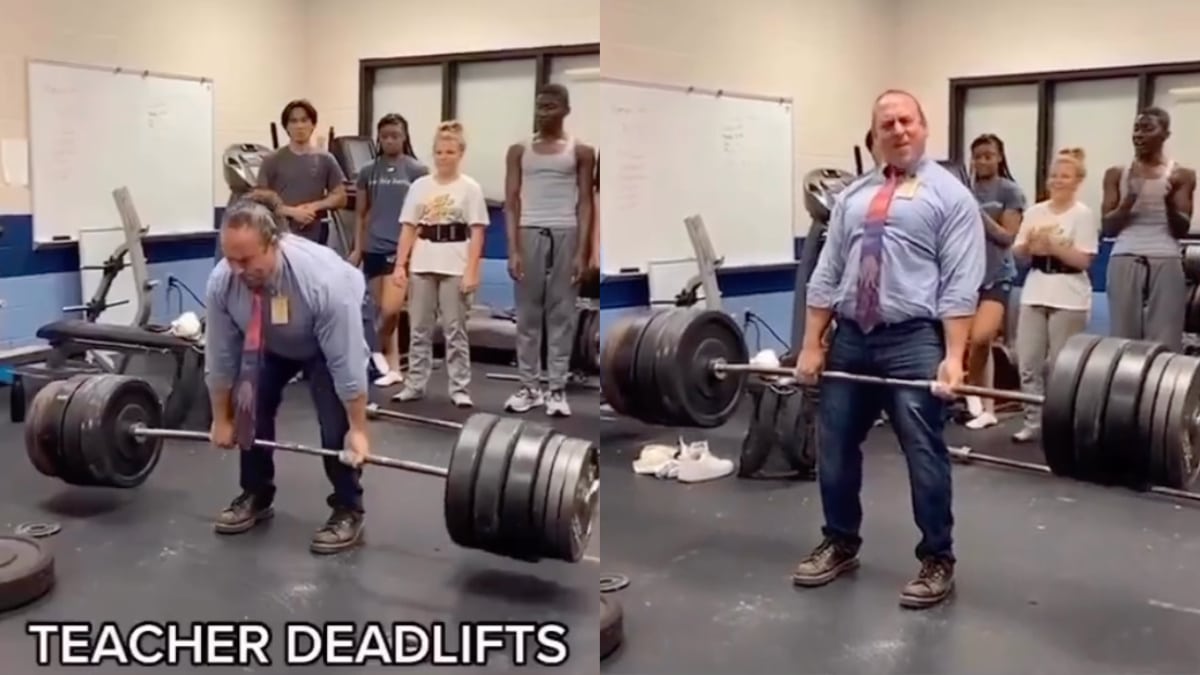
High School Principal Shocks Students with Insane 585-lb Deadlift
The Internet has provided a launching pad for many people for both good and bad reasons. While some find fame through prank videos, others gain attention for their incredible feats of strength. In a recent video posted on Instagram, a high school principal left his students in shock by lifting a huge 585-pound deadlift in the gym.
Deadlifts are one of the most productive exercises one can perform in the training room. The compound movement takes advantage of multiple muscle groups and contributes toward increasing strength in a functional manner. For powerlifters, it’s an essential exercise that they test themselves on along with bench presses and squats. It’s also a staple for strongman athletes.
While professional contenders are expected to inspire others with their heavy lifts, there have been several instances where the inspiration came from unexpected places. In Jul. 2022, a female TikToker influencer named Alice Elizabeth left her fellow gym-goers stunned with her strength after performing a huge 264.5-lb (120-kg) deadlift for six reps. The other male members had a hard time believing how easily she could lift the heavyweight.
Rapper Blueface teamed up with social media fitness influencer Bradley Martyn for a collaborative training session earlier this year. He impressed Martyn in a major way by lifting over 300 pounds on the deadlift.
86-year-old powerlifter Brian Winslow defied his age and crushed the National and World records on the deadlift three months ago. He set the new British and world record by lifting a 171-pound deadlift in the 132 pounds category for ages 85-89 at the 2023 British Drug-Free Powerlifting Championships.
74-year-old Rudy Kadlub celebrated his latest birthday in style by scoring a new PR that would leave even the younger gym-goers envious two months ago. He recorded a massive 524 pounds (237 kilograms) raw deadlift for two reps using the sumo stance.
High School principal shocks students with an insane 585-pound deadlift
In a recent Instagram post, a high school principal left the students in shock after crushing a massive 585-pound deadlift in the school gym. The students applauded after the lift.
The man in the video from last year is Alexander Mercieca of Grissom High School in Huntsville, Alabama. He is an avid fitness enthusiast who is also a certified CrossFit trainer. He continues to train hard and lifted an impressive 550-pound deadlift for three reps with ease five weeks ago.
Reactions from the fitness community came pouring in on the clip. While many praised the man for his feat of strength, some found areas to criticize regardless.
“Teaching the students a thing about lifting,” the post captioned.
“No belt straps or even right clothes,” noted a user.
“W teacher,” wrote one.
“Only belt is to hold his pants up,” commented a user.
“No belt, no wraps, jeans and a tie….. BEAST!!!” wrote another.
“Maybe he could teach them to set the bar back down instead of dropping it,” criticized one.
“Impressive, but can he teach,” criticized another.
“He can absolutely do more,” wrote a user.
One responded, “If you can pick this up, you get an ‘A.’”
“The dad strength displayed is unreal,” commented a poster.
Read also World’s Heaviest Deadlift Performances of All Time
Legendary rapper Method Man, real name Clifford Smith Jr., of the iconic hip-hop group Wu-Tang Clan, encouraged his massive fanbase with a workout update by performing heavy deadlifts at the age of 52 last month.
Fitness fans took motivation from 73-year-old powerlifter Mary Duffy who managed to smash a 310-pound deadlift, over 2.5x her body weight, with chains in a training session weeks ago.
Speaking of deadlifts, Inderraj Singh Dhillon set a new IPF deadlift World Record of 851 pounds (386-kg) in the. 120-kg weight class at the 2023 IPF World Classic Open Powerlifting Championships a few days ago. Farhanna Farid achieved a similar feat after pulling a 447.5-pound (203-kg) raw deadlift in the 52-kg category to set a new all-time World Record at the same event.
The school principal’s resurfaced clip would surely give a dose of motivation to many considering the weight he lifted at an old age.
Related:
Published: 21 June, 2023 | 3:42 PM EDT

Strongwoman Nadia Stowers Lands 690-lb Long Bar 13-Inch Deadlift PR
Nadia Stowers has made a name for herself as one of the greatest Strongwoman athletes in the world. She achieved this status through years of completing unbelievable feats of strength, as well as putting up a remarkable performance in any competition she took part in. Despite training her body continuously for years, Nadia has not reached the point of satisfaction in her career, which is why she continues to chase PRs with every session that she attends. So, her workouts tend to be very successful, with the most recent one fitting the description, as she managed to set a new 690-pound Long Bar 13-Inch Deadlift Personal Record.
Strongman and Strongwoman are arguably the most diverse strength sports in the world since even a simple exercise like the deadlift can have many variations. The 2023 WSM, Mitchell Hooper, also explained how the effects of different deadlift variations can change the difficulty. So, Nadia Stowers’ feat on the 13-inch long bar might look unusual, but it is still extremely impressive. According to Nadia, it took her three years to get the hang of deadlifting with this setup.
Nadia Stowers struggled to get the weights off the ground due to the length of the bar. However, although this is what stops the majority of people, Nadia kept pulling until she was successful.
“I love this pull for many reasons. Pushing myself beyond what I thought I could do will always be a surge for me. It literally took me 3 years to learn the long bars.”
Watch the deadlift here:
Related: Strongwoman Nadia Stowers Crushes a 525-lb (238-kg) Deadlift Three Rep PR
Judging by Nadia Stowers’ Instagram, it seems that she is currently preparing for a bodybuilding competition. She shared a posing routine not too long ago and also revealed that she will not be bulking up anytime soon. Taking into account how lean Nadia is at the moment, her new deadlift PR is even more impressive.
During her Strongwoman career, Nadia Stowers took part in multiple competitions, and won the majority of them as well. Her greatest performances were at the 2021 and 2022 U82KG World’s Strongest Woman competitions, where she came out victorious.
However, Nadia Stowers’ is mostly known for her individual lifts, as she set countless World Records during her career. So, she has previously broken Bag Over Bar, Axle Deadlift, and Log Lift World Records. These records, along with multiple major titles, make Nadia one of the strongest women in history.
Related: Strongwoman Nadia Stowers Crushed A 465 lbs (211 kg) Squat PR In Training
Nadia Stowers has always been a beast in regard to stationary strength, but her 690-pound long bar 13-inch deadlift PR is one of her greatest feats yet. In addition, she hopes to get even stronger as time passes. So, a 700-pound pull on this variation of the deadlifts could come soon for Nadia.
Published: 20 June, 2023 | 9:11 AM EDT

